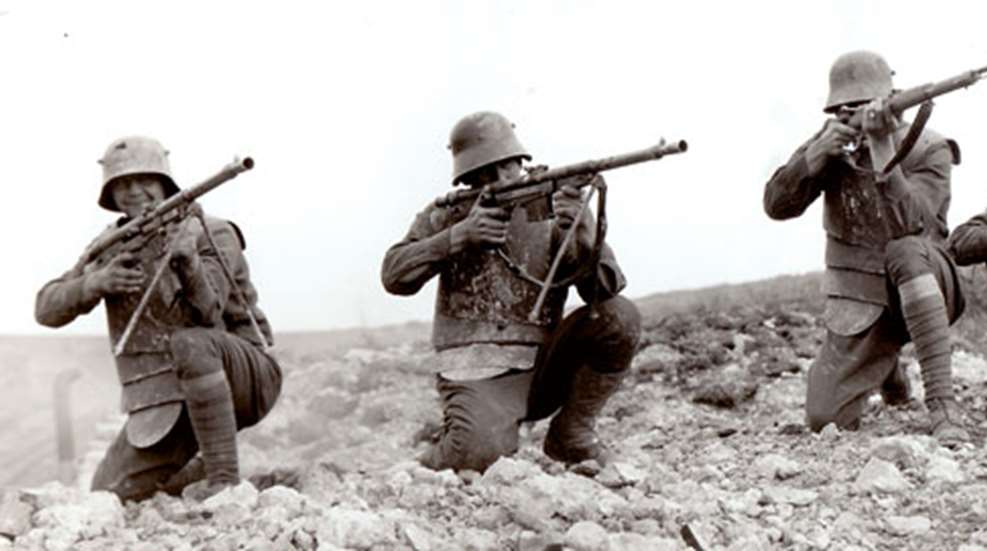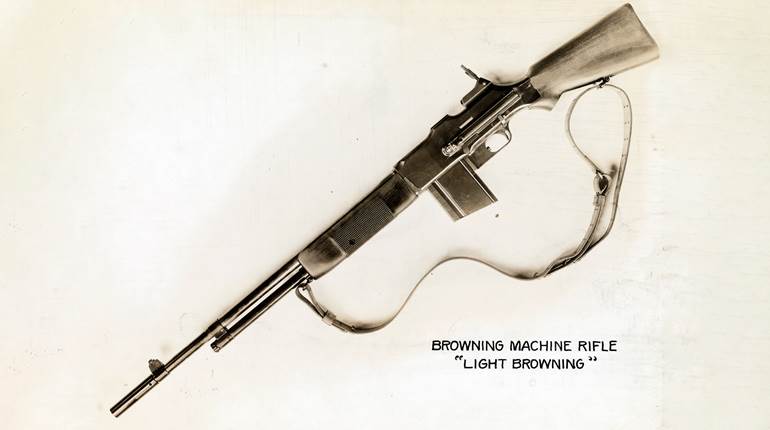
9/17/2012
The French called it Le Fusil Mitrailleur 1915 CSRG. The Doughboys and Marines of the American Expeditionary Force called it “Show-Show” or “Shoo-Shoo”—or several other names that cannot be printed in this magazine. Few arms evoke such negativity from American servicemen of World War I, and no other firearm used in combat by U.S. troops has ever been as badly derided as the crude Chauchat. Yet, foreign and ugly as it was, the Chauchat was an important addition to Uncle Sam’s arsenal in the early days of 1917, and served our troops until peace was hard-won in November 1918.
The Fusil Mitrailleur 1915 (CSRG stood for Chauchat Sutter Ribeyrolles Gladiator) was well ahead of its time. When finally deployed in useful numbers in the autumn of 1916, Col. Louis Chauchat’s automatic rifle delivered a level of man-portable infantry firepower that was unrivalled in any other army. The M1915 CSRG heralded a new era of automatic arms as it could be carried, loaded and fired by just one man. But the Chauchat’s story is an unfortunate one because Col. Chauchat’s ingenious design was clearly let down by manufacturing standards that could be described as nothing short of criminally negligent.
A soldier’s first glance at a Chauchat indicated that there was something wrong or, at the very least, not right. The exposed metal parts appear rough, as does the slab wood buttstock, and the entire gun looks as if it is an unorganized conglomeration of sheet metal stampings and scrap parts. The Gladiator factory in Paris (where almost all of the manufacturing was conducted) appears to have had no affinity for quality workmanship, and reports of substandard materials and improper heat treatment haunted the CSRG throughout the war. From the moment of its introduction to American troops, the Chauchat’s awkward appearance did not inspire confidence in men used to handling well-finished arms.
Introduced into combat during the height of static trench warfare, the Chauchat suffered from the prevailing outmoded tactics of the time, as well as the harsh physical environment of the Western Front. One of the Chauchat’s greatest flaws was its flimsy magazine, which had a maximum capacity of 20 rounds of 8 mm Lebel ammunition. Unfortunately, the magazine springs were not strong enough; so most Chauchat gunners “short-loaded” their magazines for increased reliability. Even worse, the magazine was almost completely open on its right side (to provide gunners with a quick view of available ammunition), and this exposed the gun and its ammunition to all the mud, slime and grime that the trenches could provide. Too, the magazine feed lips were easily bent, and the entire magazine itself could be easily crushed or deformed.
With all of those problems considered, the Chauchat was not just prone to jamming, it was almost guaranteed to jam. Canvas covers were eventually provided for the magazines, and while this helped a little, the horrible magazine design was not corrected by the end of the war. While it may seem like an easy remedy to a completely predictable problem, it was not addressed in time to make the Chauchat a more dirt-proof design, and many French and American gunners paid for that fact with their lives.
Easily portable automatic arms were in short supply on both sides of the line on the Western Front. German troops were used to lugging around the MG08/15, in those days considered a “light machine gun” at only 40 pounds. Small wonder that the Kaiser’s men were keen to use any 28-pound British Lewis gun they captured. Not so, however, with the 20-pound Chauchat. Despite the large numbers of captured Chauchat machine rifles available to them, the Germans apparently made no attempt to use them. I have many photos in my collection of Germans using captured Lewis guns, but I have never seen an image of a German using a Chauchat in World War I.
Each time a Doughboy attempted to fire the Chauchat from the prone position he was painfully reminded that it was not a shooter-friendly design. To avoid a punch in the eye or cheekbone (the French called this “la gifle”), the shooter must position his cheek well forward of the plug end of the long-recoil mechanism. At the same time, the shooter must also hold the short buttstock tight to his shoulder to provide enough resistance for full cycling of the recoil system. As if the rifle were not already fraught with problems, the shooter must subordinate his natural instincts and fire it with awkward positioning of his eye, cheek and shoulder. Coupled with a spindly, unstable bipod and poorly aligned sights, accurate combat shooting beyond 100 meters with a Chauchat was quite an achievement. Hits at more than 400 meters were next to impossible.
Jamming the Chauchat was not limited simply to dirt entering through the open magazine. Overheating of the long-recoil action was unavoidable, but the burning question in the minds of Chauchat gunners was how many rounds would it take to jam it? Considering that a clean, well-oiled Chauchat (where would you find one of those in 1918?) would seize up after only 300 rounds of rapid fire, a dirty rifle could be maddeningly locked up after only 100 rounds. It would often take more than 10 minutes for the barrel and sleeve to cool off enough to allow the recoiling barrel to slide forward and lock in the firing position. No amount of kicking, hammering or cursing (in English or French) would release the jammed mechanism.
It is difficult for us to imagine today but the battle-readiness of American armed forces in 1917 was woeful. Colonel Isaac Newton Lewis (inventor of the Lewis light machinegun), provided this testimony before the Senate Military Affairs Committee on December 22, 1917: “The equipment of our troops in France, the pitiful handful of men, hardly equal to the casualty lists of the British that we get week by week—the equipment of those men is an outrage and a disgrace to this country. They have neither machine guns nor a suitable supply of rifles; they have no field artillery except what we are begging and borrowing from France, which is stripped to the skin. We are not going to get armament to them in ten months from today, nor one year from today. We will not have one million armed men in the field, because America will be absolutely unable to supply the arms and ammunition required. Somebody is responsible for that; something is responsible; some system is responsible for it.”
While Col. Lewis was incorrect in his prediction of America’s ability to field a well-armed expeditionary force within a few months, his assessment provides an accurate snapshot of the situation in late 1917. That predicament was one of the primary reasons the AEF needed arms such as the Chauchat. The need was immediate, and brilliant designs such as the Browning Automatic Rifle (BAR) were still just concepts or prototypes at that point—while American troops were already fighting and dying in France.
In a letter dated Dec. 5, 1917, the French High Commissioner wrote to the U.S. Chief of Ordnance: “I beg to state that I am informed by my government that the factory manufacturing the 25,000 Chauchat rifles for the American Army expects to have the whole lot completed about March, 1918. Under these conditions I am directed to ask you whether you will be prepared to place a further order and what will be the importance of this order. This information is necessary to plan out the output of the factories concerned for 1918.”
Beginning in August 1917 and concluding with the November 1918 Armistice, the Gladiator factory in Paris was responsible for delivering approximately 16,000 Chauchats chambered in 8 mm Lebel (“Balle D”) and then in 1918, approximately 19,000 M1918 Chauchats chambered in U.S. .30 cal. (.30-’06 Sprg.). While the original 8 mm Lebel Chauchat was problematic, the revised Chauchat in .30 cal. was close to unusable.
Crippling extraction problems were caused by incorrect chamber measurements and the pathetic manufacturing standards at the Gladiator factory were even more manifest in the .30-cal. version. American ordnance inspectors rejected as much as 40 percent of the .30-cal. Chauchats. The M1918 did provide an improved bipod as well as a proper detachable box magazine design (holding 16 rounds). But the .30-’06 Sprg. cartridge overpowered the flimsy Chauchat, and the rifle was damned from the start. Very few were issued to AEF troops.
Laurence Stallings’ fantastic book The Doughboys (Harper & Row, 1963) provides details that three Americans were awarded the Medal of Honor for their heroic use of the Chauchat in France during 1918. These men were Pvt. Frank Bart of the 2nd Infantry Division, Pvt. Thomas Neibaur of the 42nd Infantry Division, and Pvt. Nels Wold of the 35th Infantry Division. Although many of the Doughboys made it home, most of the Chauchat Automatic Rifles were left in France as the Army and the Marines had no desire to keep them.
American divisions deployed to France after July 1, 1918 (including the 6th, 7th, 8th, 29th, 36th and 79th) carried the BAR with them. Incredibly, upon their arrival in France, most of these divisions had their BARs replaced with .30-cal. M1918 Chauchats, by order of Gen. John J. “Blackjack” Pershing. The first recorded use of the BAR was with the 79th Infantry Division, and that was not until Sept. 22, 1918, during the beginning of the Meuse-Argonne offensive. Just three other divisions would carry the BAR before the end of World War I.
General Pershing determined the best course of action would be to wait until most of the U.S. divisions could be fully equipped with BARs (and with a ready supply of the rifles and spare parts available) to gain the full advantage of deploying the new rifle. General Pershing also feared that if the BAR were deployed too quickly that the Germans would inevitably capture one, and seeing its great capability would reverse-engineer the weapon and make it their own.
Records of the Automatic Arms Section of the AEF present the status of automatic rifles in France as of Sept. 8, 1918: “At the present time 18 U.S. divisions have been equipped with the Chauchat. No more divisions will receive this weapon in the future. At the present time there are nine U.S. divisions equipped with the caliber .30 Chauchat. However this gun has proved to be not at all satisfactory, the cartridges sticking in the chamber after the gun becomes slightly hot. For this reason the gun has been issued as an emergency weapon and will be withdrawn as soon as the Browning Automatic Rifles are available. At the present time 27 U.S. divisions have been equipped with the Chauchat Auto Rifle, and two divisions with the British are using the British .303 Lewis machine guns. All divisions over and above this number have been equipped with the Browning Automatic Rifle.”
It is easy to dismiss the Chauchat as a useless pile of junk, a gun better off forgotten. But that would be a mistake, at least in the fact that we would not be learning from our military firearm history. That could have cruel consequences for our armed forces in years to come.
By American standards, the Chauchat was close to being a total disaster. However, we had nothing like it during the dark days of our entry into World War I during 1917, and so we truly needed it at that moment. Should we be grateful that the French shared it with us—an arm openly damned by their own troops? It is the first of many contradictions that plague the gun’s legacy. Another is that the Chauchat worked, if just barely, and in the right hands did make the difference on the battlefield.
We bought the Chauchat (the original models as well as those designed to American specifications) and we played the game of “political correctness” with our French allies. The very idea that we needed the French and their awful automatic rifle is galling to most Americans, but it is true. The French lost nearly 1.4 million men in World War I, with another 4.2 million wounded—by comparison, America lost nearly 117,000 killed—paying a high price in blood during the Great War. The contradictions continue to stack up.
By the late summer of 1918, the wonderful BAR was available, and yet the BARs were taken from the Doughboys and replaced with Chauchats—a massively disappointing contradiction! My grandfather fought in France in 1918, and I have wondered if I were just a “damned, jammed Chauchat” away from never being born? But granddad came home, and then he had a son who fought in France, too. Luckily for me, American infantry weapons were in a much better state by the time my father went ashore at Utah Beach in 1944.
So, I think it best that we remember the Chauchat, mostly for the fact that we had to use it because we were unprepared for war and thus had to pay the cost. Better still to remember all those Doughboys, up in Heaven now, having left behind the damned Chauchat in the mud of France.





































